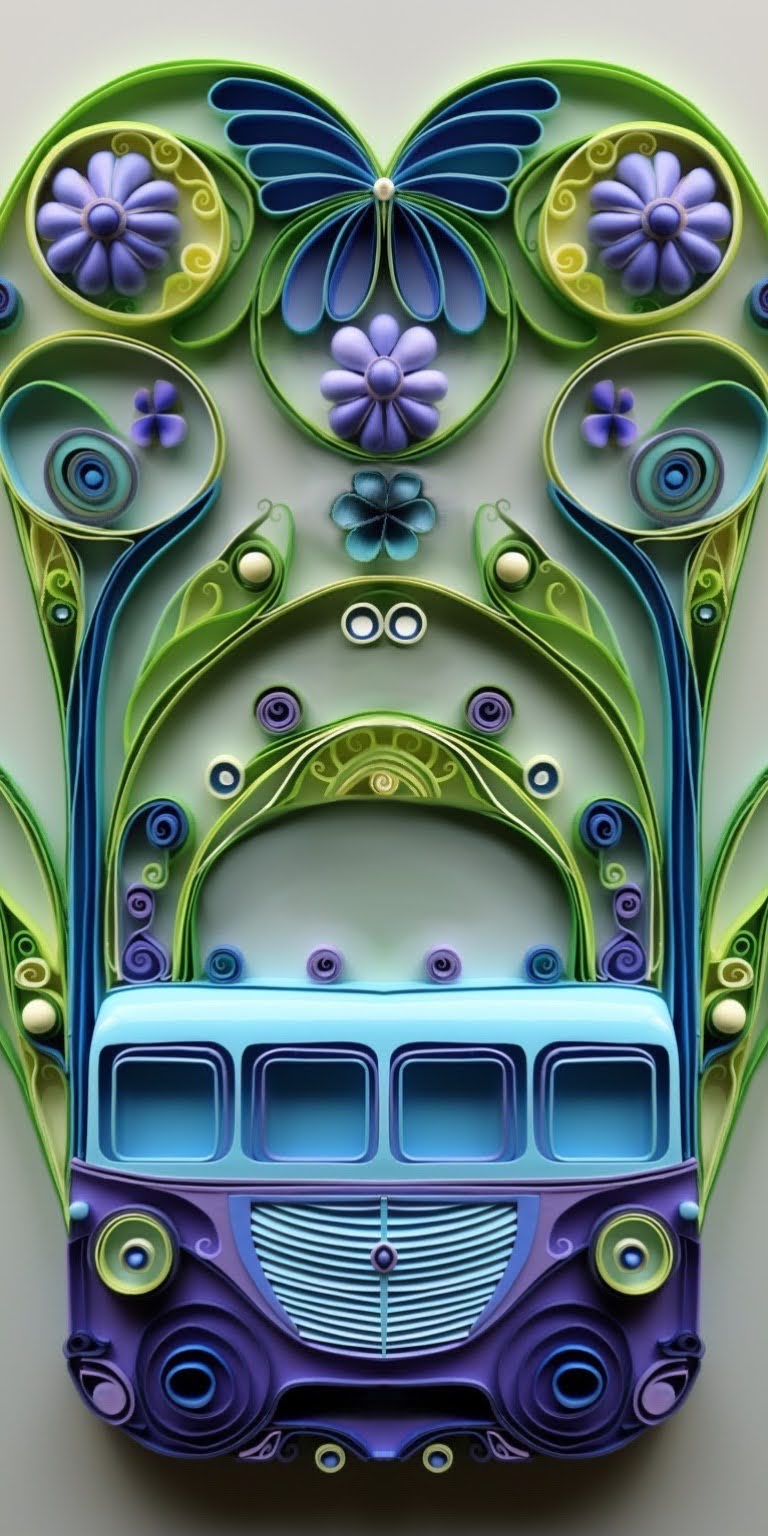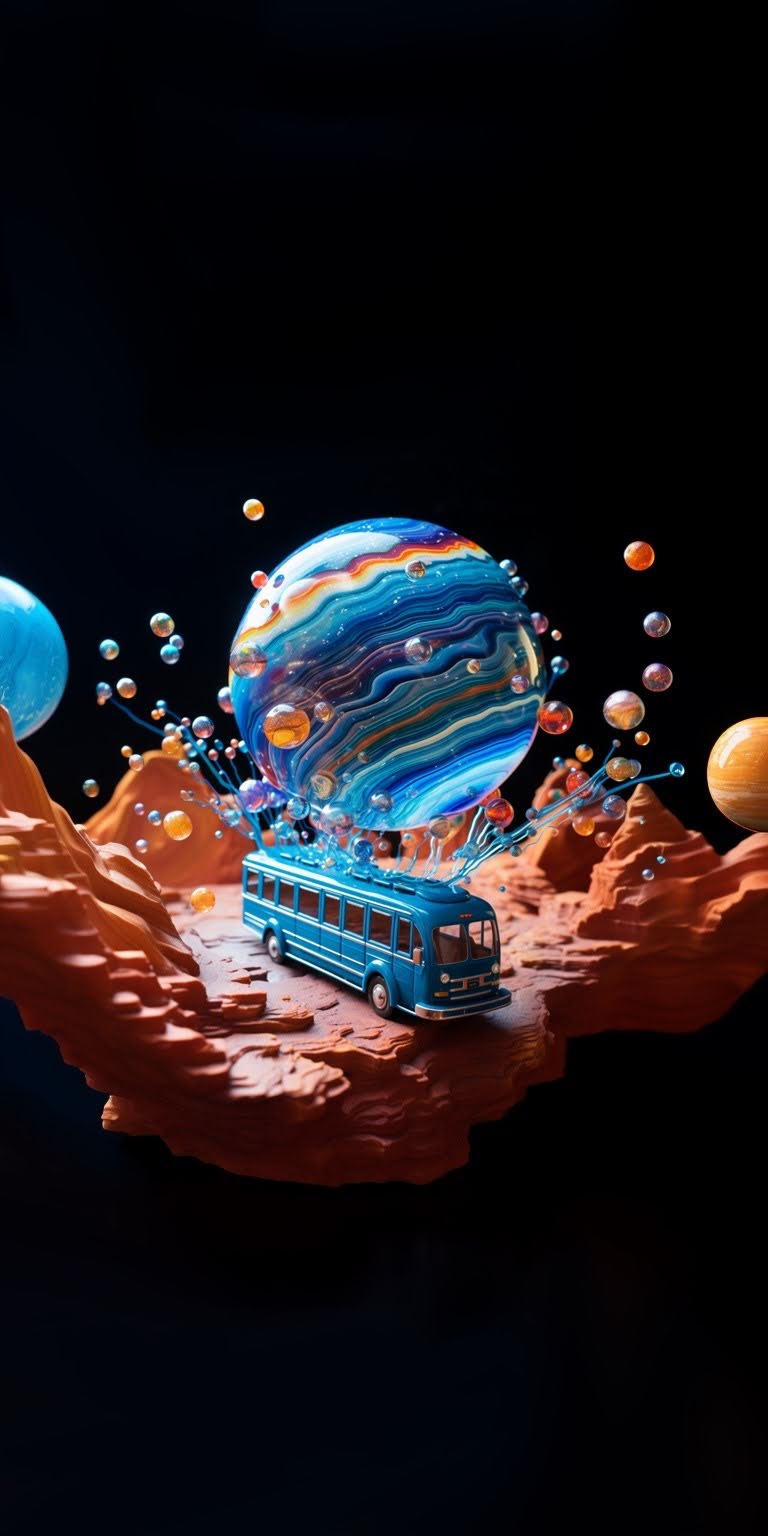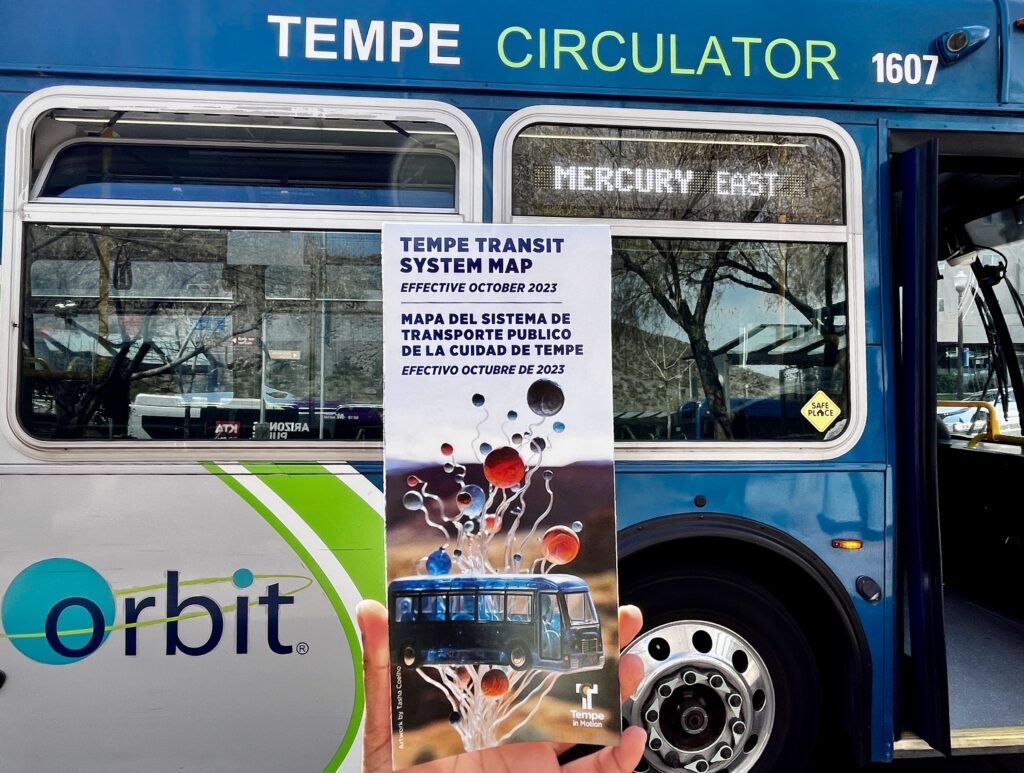ASU Space Student Ambassador Tasha Coelho transforms valley metro buses
Tasha Coelho, a senior at the ASU School of Earth and Space Exploration studying Exploration Systems Design and an ASU Space Student Ambassador, had the opportunity to embark on an exciting graphic design project with the Arizona Valley Metro transportation system. Combining her passion for space exploration and her innovative use of AI in design, Tasha has created stunning space-themed artwork for Valley Metro’s Orbit buses. Dive into her journey to discover her creative process, the role of AI in her brainstorming, and the inspiration behind her designs.
Could you share a bit about yourself, Tasha?
Hi there! I’m a SESE undergraduate researcher for the Lunar Reconnaissance Orbiter Camera and Mastcam on the Curiosity and Perseverance rovers, staff at Biosphere 2’s Space Analog for the Moon & Mars (SAM) and a 2023/2024 ASU Space Student Ambassador. My highlights here have been traveling around the Southwest with geologists, whether as a field assistant or going on field trips with spacecraft instrument principal investigators Mark Robinson and Phil Christensen. The nearby planetary analogs, including Biosphere 2, and the myriad of space missions being operated from Arizona’s institutions are why I moved here from New Jersey. An ultimate goal I have is to be an astronaut on the Moon or Mars, contributing to the discovery of answers to fundamental scientific questions.
How did this Valley Metro project come about?
Tempe and Valley Metro’s commitment to art is one of the first things I noticed upon moving here. Valley Metro has spent over $20 million on Light Rail art alone since 2004.
The way I got this opportunity is truly just another best-case scenario of cold-emailing working out. I initially reached out to Valley Metro expressing my interest in making space art and designing for them. Given Arizona’s significant involvement in space exploration, I pitched that integrating space-themed art and visuals would not only captivate passengers but also celebrate our region’s contribution to the exploration and understanding of the cosmos. I followed up with a call to Valley Metro’s customer service a couple of weeks later, and they mentioned they’d forward my email to someone higher up.
The statement below was in the email body I sent to customer service email, along with my portfolio:
“I’m a 2nd year undergraduate in the School of Earth and Space Exploration at ASU. I’m a frequent rider of the Valley Metro Orbit buses. I’ve recently been involved in the field of space art and have some ideas to enhance the rider experience, using art, on the Orbit buses (being that they are named after planets)!”
A few weeks later, while I happened to be at ASU’s 2023 AZ Space Summit, I got the email commission request to make brochure cover art for them.
Fast forward to now, most of the Orbit buses have brochure holders, and it’s been a daily joy peeking through the bus windows as they pass by me on the sidewalk and seeing my brochure cover art in them.
What inspired the designs you created?
Our solar system! Since the Orbit buses are all named after planets, I drew inspiration from the celestial bodies in our solar system.
Regarding the style, I incorporated elements from my childhood hobbies, such as quilling paper and creating perspective drawings. I included these as text inputs for some of the light rail designs.



Could you describe your design process and any programs you used? What led you to incorporate AI into your project?
Diving right in, I started by dividing the back of a scrap piece of paper into 16 rectangles and penciled a different design in each one. I recognized an importance in seeing what I could come up with before using external tools.
There were so many different styles and ideas I had drafted that I wanted to try out and actualize, and AI was enabling me to quickly explore several different looks. I continued to experiment with different text inputs, just as I have enjoyed doing since the summer of 2022. I love getting completely engrossed in a flow state, keeping tabs on what inputs cause what outputs, and I have tons of fun engaging with the art of prompt engineering. AI art generated by Photoshop, DALL-E, and Midjourney is massively improving, but it still has the occasional proclivity to put bus wheels in the windows, so I fixed those types of things manually in post. I also tailored the buses and light rail to look more like those operated by Valley Metro.
This was my first ever commission, and I had consulted ChatGPT with how to go about getting feedback. I had a bunch of ideas, but they only needed one brochure cover art. I followed up in the email thread attaching a photo album of drafts I had come up with so far and asked if the direction I was going was okay, and which design they prefer I go with. They said they loved all of them, and even raised the commission offer to purchase all of them. Wow!
It was amazing having complete creative freedom; the only constraints were the dimensions, dpi (dots per inch, essentially resolution), and that it should have a bus or rail. Later, I realized some of the pieces I made didn’t meet an unspoken yet obvious constraint, which was leaving room for text. However, Valley Metro’s last response mentioned they’d be using the different pieces for different purposes, so I included them in the final collection anyway.
One day last September after Valley Metro printed the design, I got on an Orbit bus, grabbed the brochure with my design from the rack, and asked a willing stranger to give their honest opinion on the design, not revealing my role in making it or asking any leading questions. It was at that point I realized the spheres didn’t necessarily resemble planets unless you had the prior context of knowing the theme of the Orbit routes. In the updated version, I transformed one of the spheres into a ringed planet to make it more obvious.
Could you share some advice for beginners who are interested in using AI?
Let yourself be fascinated, not intimidated, by the complexity of it. I started in the summer of 2022, when the barrier to making generative art was exceptionally lower than ever. Upon seeing AI art others had created, I was eager to see what things I could produce with different inputs and ideas. Before DALL-E or MidJourney had been released, I’d experience immense awe dabbling with PyTTI on Google Colab from @sportsracer48’s patreon. Shortly after I had watched an AI-made music video and became fascinated while watching it realizing I knew how it was made and that I could create similar videos.
The first 37 pages of “The Practice of Art and AI” has a lot of fantastic and thought-provoking quotes that helped me consciously shape my relationship with AI.
I thank the many online resources that are often affordable or free!
What are your aspirations after graduation? Do you foresee yourself remaining active in design or using AI in your future projects?
I plan to stay involved with human and robotic space exploration projects! Along with continuing to educate myself and stay up to date with AI, leveraging it to improve life on Earth while doing my part to prevent its unethical uses.
Explore the ASU Space Student Ambassador Program and learn how you can participate in this competitive ASU undergraduate leadership and professional development program for the next generation of space sector leaders.
Stay updated with the ASU Interplanetary Initiative by subscribing to the newsletter and the ASU Space student mailing list for the latest news and student opportunities.
